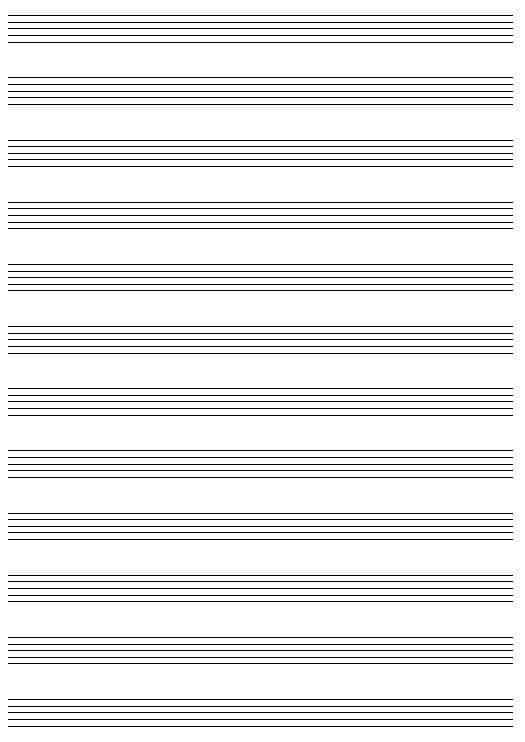MUSIC PAPER 2 GRADE 12 QUESTIONS - AMENDED SENIOR CERTIFICATE EXAMS PAST PAPERS AND MEMOS MAY/JUNE 2018
Share via Whatsapp Join our WhatsApp Group Join our Telegram GroupMUSIC
PAPER 2
GRADE 12
AMENDED SENIOR CERTIFICATE EXAMS
PAST PAPERS AND MEMOS
MAY/JUNE 2018
INSTRUCTIONS AND INFORMATION
- This question paper consists of THREE sections:
SECTION A: Aural (10)
SECTION B: Recognition (12)
SECTION C: Form (8) - QUESTION 1, QUESTION 2, QUESTION 3 and QUESTION 7 are COMPULSORY.
- Answer QUESTION 4 (Western Art Music (WAM)) OR QUESTION 5 (JAZZ) OR QUESTION 6 (Indigenous African Music (IAM)).
- Write ALL your answers on this question paper. Use a pencil for music notation and blue or black ink for the other answers.
- This examination will be written while candidates are listening to a CD.
- The music teacher of the centre must conduct the examination in the presence of the invigilator.
- The last page of this question paper is manuscript paper intended for rough work. The candidate must NOT remove this page.
- Candidates may NOT have access to any musical instrument for the duration of this examination.
- Candidates must take note of the mark allocation of each question to provide enough information in their answers.
- Write neatly and legibly.
INSTRUCTIONS FOR THE PERSON OPERATING THE SOUND EQUIPMENT
|
SUMMARY OF MARKS
SECTION A: AURAL | TOTAL |
QUESTION 1 (COMPULSORY) | 4 |
QUESTION 2 (COMPULSORY) | 6 |
SUBTOTAL | 10 |
SECTION B: RECOGNITION | TOTAL |
QUESTION 3 (COMPULSORY) | 4 |
QUESTION 4 (WAM) OR | 8 |
QUESTION 5 (JAZZ) OR | 8 |
QUESTION 6 (IAM) | 8 |
SUBTOTAL | 12 |
SECTION C: FORM | TOTAL |
QUESTION 7 (COMPULSORY) | 8 |
SUBTOTAL | 8 |
GRAND TOTAL | 30 |
QUESTIONS
SECTION A: AURAL
QUESTION 1
Play Track 1 THREE times in succession. |
1.1 Which ONE of extract (a), (b) or (c) below best represents the solo voice part? Make a cross (X) in the appropriate block. 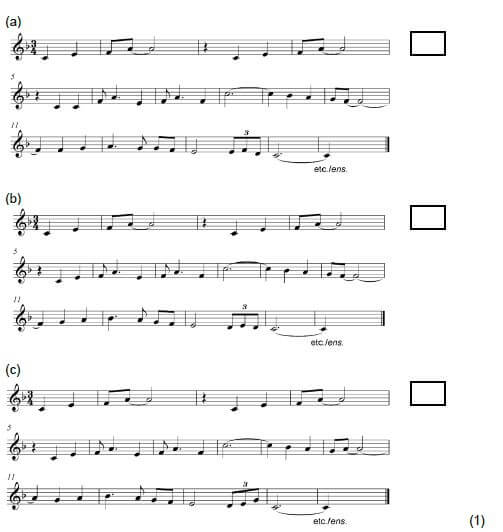
Play Track 2 TWICE in succession. |
1.2 Listen to the melodic and rhythmic phrase. Notate the rhythm of the missing notes in bars 2–3 below.  (3) [4]
(3) [4]
Play Track 2 TWICE again. |
QUESTION 2
Play Track 3 ONCE to provide a general overview. |
Listen to the extract below. Answer the questions that follow. 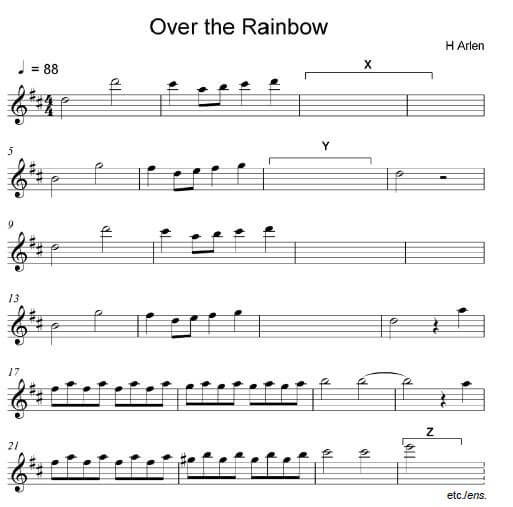
Play Track 4 TWICE. |
2.1 Describe the role of the guitar in this extract. (1)
2.2 The notation of bars 3 and 4 has been omitted at X on the score. Fill in the missing pitches and note values that correspond with the music that you hear. (3)
Play Track 5 TWICE. |
2.3 Name the compositional technique used at Y. (The track starts in bar 5.) (1)
Play Track 6 TWICE. |
2.4 Name the interval formed between the given note and the missing note at Z. (The track starts with an upbeat to bar 21.) (1) [6]
TOTAL SECTION A: 10
SECTION B: RECOGNITION OF MUSIC CONCEPTS
QUESTION 3: GENERAL LISTENING (COMPULSORY)
Listen to the following tracks and answer the questions that follow.
Play Track 7 TWICE. |
3.1 With which items in COLUMN A do you associate the music that you hear in Track 7? Make a cross (X) in TWO appropriate blocks. (2)
COLUMN A | Track 7 |
Marimba | |
Double bass melody | |
Dorian mode (modal minor) | |
Major key | |
Piano introduction | |
Organ introduction |
Play Track 8 TWICE. |
3.2 With which items in COLUMN A do you associate the music that you hear in Track 8? Make a cross (X) in TWO appropriate blocks. (2)
COLUMN A | Track 8 |
Horn section | |
Ragtime | |
Swing | |
Major key | |
Starts with djembe introduction | |
Starts with floor tom-tom |
Play Track 9 and Track 10 TWICE each. |
3.3 Listen to the two versions of Dona Nobis Pacem (Track 9 and Track 10) and answer the questions that follow.
3.3.1 With which items in COLUMN A do you associate the music that you hear in Track 9 and Track 10? Make a cross (X) in TWO appropriate blocks for EACH track. (4)
COLUMN A | Track 9 | Track 10 |
Call and response | ||
SATB choir | ||
Piano accompaniment | ||
Starts with an introduction | ||
Minor key | ||
Children's choir | ||
Starts with a monophonic texture | ||
A cappella |
3.3.2 With which TWO genres do you associate both versions of the work? Make a cross (X) in TWO appropriate blocks. (2)
Choral work | Art song | Vocal canon | Hymn | Vocal fugue |
3.3.3 Indicate whether the statements below are TRUE or FALSE. Make a cross (X) in the appropriate blocks.
TRUE | FALSE | ||
(a) | Both performances begin with an upbeat. | ||
(b) | Both performances end with a perfect cadence. | ||
(2)
(12 ÷ 3) [4]
Answer QUESTION 4 (WAM) OR QUESTION 5 (JAZZ) OR QUESTION 6 (IAM). QUESTION 4: WAM
4.1 Listen to the extracts and answer the questions that follow.
Play Track 11 TWICE. |
4.1.1 From which movement of Beethoven's Symphony No. 6 is this extract taken? (1)
Play Track 12 TWICE. |
4.1.2 With which items in COLUMN A do you associate the music that you hear in Track 12? Make a cross (X) in THREE appropriate blocks. (3)
COLUMN A | Track 12 |
Development | |
Adagio | |
Coda | |
Flute and oboe melodic material | |
Clarinet and trumpet melodic material | |
Triplet figure in accompaniment | |
Compound triple time | |
Repetition of motif in different keys |
4.1.3 Which prominent dynamic feature do you hear in this extract? (1)
4.2 Listen to the extracts and answer the questions that follow.
Play Track 13 TWICE. |
4.2.1 Complete the table below by giving a description of EACH item in Track 13. (4)
ITEM | DESCRIPTION |
Work | |
Style period | |
Tempo | |
Dynamics |
Play Track 14 TWICE. |
4.2.2 Which ONE of these Italian terms best describes the mood of the entire extract? (1)
Giocoso | Espressivo | Con fuoco | Smorzando |
4.3 Listen to the extracts and answer the questions that follow.
Play Track 15 ONCE. |
4.3.1 Name the TWO characters who sing this duet. (2)
Play Track 16 TWICE. |
4.3.2 Which type of articulation do you hear in the accompaniment part of this extract? (1)
Play Track 17 TWICE. |
4.3.3 Name the cadence that you hear at the end of this extract. (1)
4.3.4 Give a suitable Italian/German term that describes the mood or character of this music. (1)
Play Track 18 TWICE. |
4.3.5 Give the term for the vocal decoration in the soprano part on the single word, 'an'. (1)
(16 ÷ 2) [8]
TOTAL SECTION B: 12
OR
QUESTION 5: JAZZ
5.1 Listen to the extracts and answer the questions that follow.
Play Track 19 TWICE. |
5.1.1 With which items in COLUMN A do you associate the music that you hear in Track 19? Make a cross (X) in THREE appropriate blocks. (3)
COLUMN A | Track 19 |
Bass and drum introduction | |
Pentatonic scale | |
Piano and voice in unison | |
Boogie-woogie | |
Syncopation | |
Kwêla | |
Melodic ostinato | |
Skiffle beat | |
Ghoema beat |
Play Track 20 ONCE. |
5.1.2 Which instrument(s) play(s) the melody? (1)
5.1.3 Name TWO features of this melody. (2)
Play Track 21 TWICE. |
5.1.4 Give ONE or TWO word(s) to describe the style of the piano part. (1)
5.2 Listen to the extracts and answer the questions that follow.
Play Track 22 TWICE. |
5.2.1 Name TWO South African artists/bands with which you associate this extract. (2)
5.2.2 Briefly describe the role of the instruments below in this extract. (3)
INSTRUMENT | DESCRIPTION |
Drum kit | |
Bass guitar | |
Saxophone |
5.3 Listen to the extract and answer the questions that follow.
Play Track 23 TWICE. |
5.3.1 Complete the table below by giving a description of EACH item in Track 23. (3)
ITEM | DESCRIPTION |
Tonality | |
Mood | |
Style |
5.3.2 This melody is played as a call and response. Name the instrument playing the call. (1)
(16 ÷ 2) [8]
TOTAL SECTION B: 12
OR
QUESTION 6: IAM
6.1 Listen to the extract and answer the questions that follow.
Play Track 24 ONCE. |
6.1.1 Identify the style of music in this extract. (1)
6.1.2 Give TWO reasons for your answer to QUESTION 6.1.1. (2)
6.1.3 Name TWO artists which you associate with this extract. (2)
6.2 Listen to the extracts and answer the question that follows.
Play Track 25 and Track 26 in succession. |
With which items in COLUMN A do you associate the music that you hear in Track 25 and Track 26? Make a cross (X) in TWO appropriate blocks for EACH track. (4)
COLUMN A | Track 25 | Track 26 |
Aerophones | ||
Monophonic texture | ||
Syncopation | ||
Guitar introduction | ||
Descending melodic motive | ||
Ukuvamba | ||
Dipoko (Praise poetry) |
6.3 Listen to the extracts and follow the instructions that follow.
Play Track 27 ONCE. |
6.3.1 Describe TWO features of the rhythmic material used in this extract. (2)
Play Track 28 ONCE. |
6.3.2 Identify the vocal technique that you hear in this extract. (1)
6.3.3 Explain the purpose of the vocal technique used in this extract. (1)
6.4 Listen to the extracts and follow the instructions that follow.
Play Track 29 ONCE. |
6.4.1 Identify the style of music in this extract. (1)
6.4.2 Give TWO reasons for your answer to QUESTION 6.4.1. (2)
(16 ÷ 2) [8]
TOTAL SECTION B: 12
SECTION C: FORM
QUESTION 7
Read and study the questions for ONE minute.
Play Track 30 ONCE to provide a general overview. |
Listen to the piece below while you study the score. 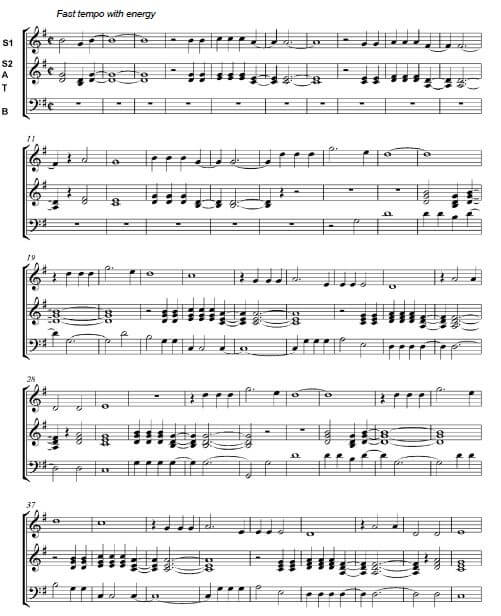
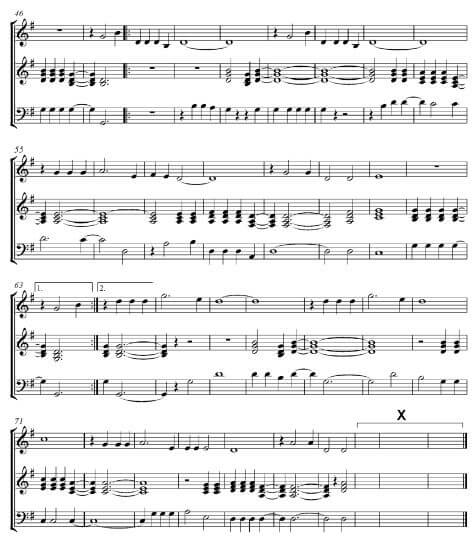
Play Track 30 again. |
7.1 What is the overall form of this piece? (1)
7.2 Motivate your answer to QUESTION 7.1 by giving a schematic layout of the form. Use the table below. (3)
SECTION | BAR NUMBERS |
7.3 Name the key of this piece. (1)
Play Track 31 TWICE. |
7.4 Does the work start with a homophonic or polyphonic texture? (1)
Play Track 32 ONCE. |
7.5 Choose the term which best describes the vocal technique in this piece. Make a cross (X) in the appropriate block. (1)
Yodelling | Crepitation | Ululation | Melisma |
Play Track 33 TWICE. |
7.6 Name the cadence at the end of the piece in bars 78–80 at X. (The track starts with the upbeat to bar 78.) (1)
Play Track 34 ONCE for a final overview. |
TOTAL SECTION C: 8
GRAND TOTAL: 30
